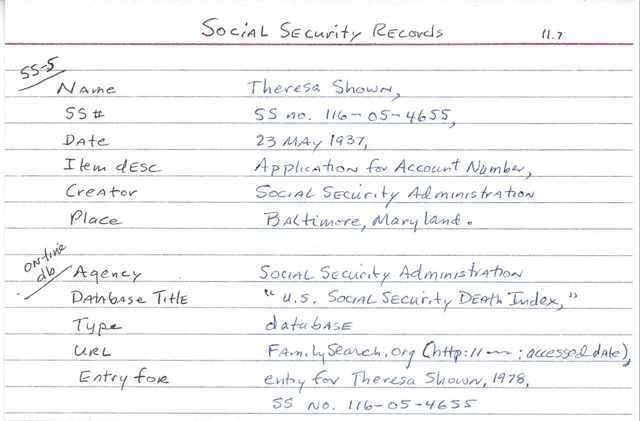In response to my blog post, How Important are Formal Citations?, reader Karen Cavanaugh sent me an excellent email about why she’s taken the trouble to format her sources in the format prescribed by Evidence Explained and how she makes it easier on herself. I liked it so much, I asked whether I could turn it into a guest post. She graciously said yes, so I present to you Organize Your Family History’s first guest post. Take it away, Karen!
I had been aware of the Evidence Explained book and used the website in the past but resisted implementing the standard in documenting my sources as it seemed so demanding and required more detail than I was accustomed to doing. I found it too tedious to master and just the weight and scope of the book made it harder to commit.
But one day as I was organizing some files I found an old family history created by a distant cousin using the old Family Tree Maker. It included some new information on my family and boy, was I excited. Until I looked at sources. Dismay! The sources were so skimpy as to be useless – I had a hard time deciphering them. I made calls to libraries and repositories in the respective area but no one could identify the one citation I needed. As a last resort I went down to the Allen County Public Library and found a very helpful person who was able to guess at the reference it was alluding to, took me to the shelf and there is was! Lesson learned.
I have always documented my sources (I have about 950 in Reunion) but this experience made me wonder if I was doing the best I could in my own work and convinced me to look at EE again. Like you, I tried the templates in Reunion but found them restrictive and especially difficult to modify the punctuation so they printed in a readable and standard manner.
Even after studying many of the sections of the book and trying to understand the logic behind it all, I still struggled to find an efficient way to implement it. Then one day I tried creating a 4” x 6” cards (see photo) for each major kind of source and rather than having to pick up the heavy book and look it up each time, I could use the cards as guides. And so I did and it worked. After adopting this aid and entering all my new sources using these cheat cards I was able to remember many of the formats without consulting the cards and now can write many of the sources from memory.

I put the cards in one of those cheap 4″ x 6” photo books that cost about a dollar and can flip through them quickly. I love not having to return to looking them up in EE.
On the sample card the top portion guides a citation for a SS-5 (application for SS number) and is substantially different than the second citation for an on-line entry found in the SS Death Index. Why is that important? Because the application will contain the applicant’s birth date and place, the names of mother and father, and date of application. The SS Death Index just provides the name, SS number, date of death and state where SS was issued. If I were reviewing the sources in a book or report, the citation for the application would jump out at me. I’d definitely want to consult that record!
In Reunion I now use the free form format to create a source. I also do a lot of copy and pasting the citations from on-line sites into Reunion, particularly FamilySearch as they seem to have adopted much of the EE standard. Often I use your idea of copy and paste in the preview section in the source window. Over couple of days I was able to edit all 950 sources in my family file and am very pleased with the results.
The most important benefit to me is that my sources now are standard and consistent when I use the Book feature or report features in Reunion. I am confident any researcher coming behind me will be able to locate the source without difficulty.
Another benefit is the EE citation will include the access date and this has been helpful on several sites such as Find A Grave because contributors often come back to add more information and that helps prompt me to remember to return to the site periodically for a particular ancestor. And last, I noticed the EE citation often includes the birth and death dates of the person to help tell same-name ancestors apart. For example, I have many John Boyers in my tree and now when I review sources it is clear to which person it refers (John Boyer 1785-1826).
I don’t hesitate to modify the EE format when I need to. Often I will add a brief comment such as “this book contains four sections the pages of which are renumbered at the start of each section.”
A brief note about me: I am a “Roots generation” genealogist and the daughter of a career officer who served in WW II and a mother born in Texas. I am retired from Parkview Health System in Fort Wayne, Indiana. My current project is digitizing my father’s 300 letters he wrote home during the war. I give presentations on my journey to discover his service record to genealogy groups, Air Force associations, and anyone else who cares to listen! I have a son in Denver and twin sister in Indianapolis.
I think this is great food for thought and makes the idea of using the Evidenced Explained format less daunting and more compelling. I think I would probably use Evernote, rather than index cards, but the idea of using a “cheat sheet” to make it easier remains the same. Thank you, Karen!
